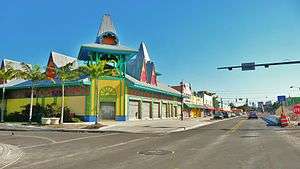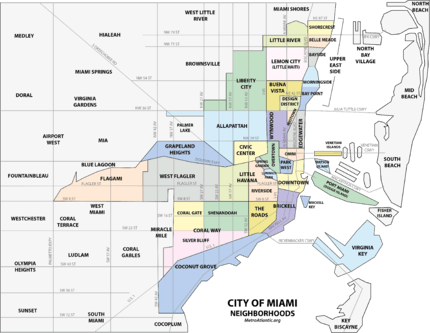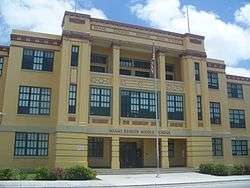Little Haiti
Little Haiti (French: La Petite Haïti, Haitian Creole: Ti Ayiti),[1] is a neighborhood of Miami, Florida, United States. It is known historically as Lemon City, Little River and Edison. It is home to many Haitian immigrant residents, as well as many residents from the rest of the Caribbean. The fastest growing group in the area is Hispanic.
Little Haiti La Petite Haïti Ti Ayiti | |
|---|---|
Neighborhood of Miami | |
 Caribbean Marketplace | |
| Nickname(s): Lemon City (historic name) | |
 Little Haiti neighborhood within the City of Miami | |
| Coordinates: 25.824385°N 80.190711°W | |
| Country | United States |
| State | Florida |
| County | Miami-Dade County |
| City | Miami |
| Government | |
| • City of Miami Commissioner | Keon Hardemon |
| • Miami-Dade Commissioner | Audrey Edmonson |
| • House of Representatives | Dotie Joseph (D) and Cynthia Stafford (D) |
| • State Senate | Larcenia Bullard (D), and Oscar Braynon (D) |
| • U.S. House | Frederica Wilson (D) |
| Elevation | 7 ft (2.1 m) |
| Population (2010) | |
| • Total | 29,760 |
| • Density | 9,946/sq mi (3,840/km2) |
| Time zone | UTC-05 (EST) |
| ZIP code | 33127, 33137, 33138, 33150 |
| Area code(s) | 305, 786 |
Little Haiti is a known neighborhood of Haitian exiles.[2] The area is characterized by its French–Creole designations,[3] with its street life, restaurants, art galleries,[4] dance, music, theatre performances, family owned enterprises, and other cultural activities.[3][5][6]
Steeped in the complex and rich cultural histories of Caribbean immigrants who brought life to its area, Little Haiti has evolved into a colorful beacon in Miami’s arts communities. Throughout the years, small businesses like celebrated record stores, kitsch bars, and authentic eateries have eased into the neighborhood, creating their own particular patchwork within the already distinct Little Haiti.
A bronze statue of General Toussaint L'Ouverture, the father of the Haitian Revolution, stands roughly at thirteen-feet on N Miami Avenue and 62nd Street."[3]
History
The area now known as Little Haiti was called Lemon City for well over a century. Several people settled near Biscayne Bay north of the Miami River after the civil war, squatting on unclaimed land. Some of the squatters eventually applied for homestead grants for the land they were squatting on. By 1889 a community had formed, with a post office named "Motto". "Lemon City" replaced "Motto" as the name of the community by 1893. A school had opened in 1890, and Lemon City also included several businesses and a newspaper, as well as port facilities on Biscayne Bay. With the extension of the Florida East Coast Railway to Miami in 1896, Miami quickly overshadowed Lemon City.[7]
Viter Juste, a noted Haitian businessman, activist and respected community leader, came up with the name of Little Haiti. According to Jean-Claude Exulien, a retired professor of history and friend of Juste's since 1977, Juste wrote an article in the Miami Herald in which he first referred to the neighborhood as "Little Port-au-Prince." However, editors at the Miami Herald found the name, "Little Port-au-Prince," too long, so the newspaper shortened the term in the headline to Little Haiti.[8] Over the passionate objections of historians and African-Americans, Miami commissioners in May 2016 voted in favor of designating Little Haiti as an official neighborhood with boundaries overlapping the historic Lemon City, which was founded by Bahamian immigrants before Miami existed.[9]
Borders
The southern border is North (NW/NE) 54th Street, west to Interstate 95 and north along the Miami city boundary on North (NW/NE) 80th Street. It then goes back down along East (NE) Second Avenue.[10]
Demographics
As of 2000, Little Haiti had a population of 29,128[11] , with 9,368 households, and 6,181 families residing in the neighborhood. The median household income was $18,887.49. The racial makeup of the neighborhood was 64.92% Black or African American, 4.78% White (non-Hispanic), 14.74% was Hispanic or Latino of any race and 15.56% other races.[11] Hispanic people are the fastest growing group in the area.
The zip codes for the Little Haiti include 33127, 33137, 33138, and 33150. The area covers 3.456 square miles (8.95 km2). As of 2000, there were 14,708 males and 15,357 females. The median age for males were 31.0 years old, while the median age for females were 33.8 years old. The average household size had 3.0 people, while the average family size had 3.7 members. The percentage of married-couple families (among all households) was 27.6%, while the percentage of married-couple families with children (among all households) was 13.8%, and the percentage of single-mother households (among all households) was 20.7%. 2.1% of the population were in nursing homes. The percentage of never-married males 15 years old and over was 21.7%, while the percentage of never-married females 15 years old and over was 22.0%.
Attractions
Food
Rooted in the Haitian immigrants that sought refuge here in the ’80s, today Little Haiti, has some Afro-Caribbean culture mixed with global trends. Restaurants in this area showcase a diversity and mix of tastes and settings.
Culture
Little Haiti is a small, non-touristy pocket in Miami where you can experience authentic Haitian culture and flavors. Go there for a real glimpse of life in the Afro-Caribbean culture and a taste of what the island’s unique ambiance and people have to offer.
Little Haiti’s main strip is NE 2nd Avenue. This region is “ripe for improvement” as one local activist in the area put it. Neighboring Wynwood and Design District have quickly become popular arts and culture havens with streets lined with galleries and commercial art storefronts. The whole area, in just a handful of years, has been overtaken by an artistic energy and an appreciation for high-design and street-art. It’s only natural that the area north of the Design District, nestled due north of these two increasingly popular neighborhoods, deserves some attention of its own.
With the development of Wynwood and the Design District and the increasing prices for space in those areas, Little Haiti and Little River have emerged as an indie arts haven.
The eventful programming at the Little Haiti Cultural Center offers just some of the local community initiatives that visitors are welcome to enjoy. Located next door, The Caribbean Marketplace was designed by Charles Harrison Pawley in the style of the typical Haitian gingerbread architecture. The colorful pastel buildings with funky cutout shapes are a great place to stop and peruse local Haitian goods.
Parks
- Athalie Range Park[12] (named after M. Athalie Range)
- Lemon City Park between NE 58th Terrace and NE 59th Street. [13]
- Little Haiti Soccer Park[14]
Education
Miami-Dade County Public Schools runs area public schools. Schools within Little Haiti include:
Public schools

Elementary schools
Middle schools
- i-tech Prep Academy
- Miami Edison Middle School[14]
High schools
- Itech @ Thomas Edison Educational Center
- Miami Edison Senior High School
Libraries
Miami-Dade Public Library System operates all area public libraries, including:
- Lemon City Branch Library
- Edison Center Library[20]
- Little River Library[21]
Cultural institutions
- Caribbean Marketplace[22]
- Cathedral of Saint Mary[14]
- The Haitian Cultural Arts Alliance[23]
References
- Martone, Laura. "Moon Florida Keys". Retrieved 27 January 2015.
- Fodor's Travel: Little Haiti
- Nijman, Jan (2011). "Miami: Mistress of the Americas". p. 158. ISBN 9780812242980. Retrieved 31 May 2016.
- Sokol, Brett, ed. (23 November 2015). "Miami's Art World Sets Sights on Little Haiti Neighborhood". New York Times. Retrieved 31 May 2016.
- Miami, Greater Miami and the Beaches: Little Haiti - La Petite Haiti
- Staff, ed. (27 April 2015). "Little Haiti: A Taste of Culture, Food And Art". The Harlem Times. Retrieved 31 May 2016.
- Blazek, Ron (1982). "Library in a Pioneer Community: Lemon City, Florida" (PDF). Tequesta: The Journal of the Historical Association of Southern Florida. 1 (42): 39–55 – via Florida International University Digital Collections.
- "Viter Juste, Haitian community pioneer and leader, dies at 87". Retrieved 2015-09-04.
- Smiley, David, ed. (26 May 2016). "What's in a name? Little Haiti boundaries now official". Miami Herald. Retrieved 31 May 2016.
- Vela, Hatzel, ed. (26 May 2016). "Miami commissioners vote in favor of designating area as Little Haiti". Local10. Retrieved 31 May 2016.
- "Demographics of Little Haiti Miami, FL". miamigov.com. Archived from the original on 2008-05-17. Retrieved 2008-06-11.
- Miami - Parks & Recreation: Athalie Range Park
- Miami - Parks & Recreation: Lemon City Park
- Barber, Timothy A. (ed.). "The Legacy of Lemon City/the Magic of Little Haiti". Miami Black Visitor Guide. Archived from the original on 10 May 2017. Retrieved 31 May 2016. (adapted from Gepsie M. Metellus)
- Miami - Historic Sites and Districts Cushman School
- Jeannot, David, ed. (31 May 2012). "Elementary School Hosts White Hot Heat Party". NBC Miami. Retrieved 31 May 2016.
- National Center for Education Statistics (NCES) - Jesse J. McCrary Elementary School
- Klein, Lee, ed. (7 May 2010). "Fine Restaurants at Morningside Elementary Fundraiser Tonight (Updated)". Miami New Times. Retrieved 31 May 2016.
- Hines, Bea L., ed. (3 December 2015). "Friends and Neighbors: Alvin Ailey director Robert Battle's story told in children's book". Miami Herald. Retrieved 31 May 2016.
- "Miami-Dade Public Library System Edison Center Branch Library". www.mdpls.org. Retrieved 2019-01-06.
- "Miami-Dade Public Library System Little River Branch Library". www.mdpls.org. Retrieved 2019-01-06.
- Fleuranvil, Fabiola, ed. (16 July 2014). "Little Haiti's Caribbean Marketplace Reopens". Miami.com. Archived from the original on 4 April 2016. Retrieved 31 May 2016.
- Green, Nadege, ed. (5 May 2015). "The Haitian Cultural Arts Alliance Among 73 Knight Arts Finalists". WLRN. Retrieved 31 May 2016.
